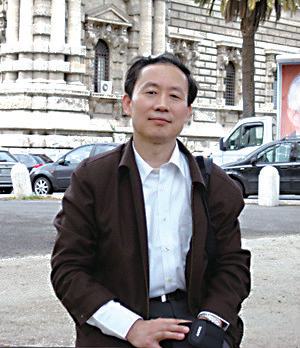
By Lv Guoying
I
In simple terms, Qi Mo (Ink) Ling Xiang (Form) is a few words, a piece of vocabulary and a phrase. Generally speaking, it is a few viewpoints, a proposition and a concept. In its greater complexity, it is a major category, a system and an idea.
According to the above logic of language patterns and rhythmic forms, the true significance and value of Qi Mo Ling Xiang’s great complexity may be its essential and simple meaning. Qi Mo Ling Xiang is simple; the words are extracted from the ancient and ever-expanding civilization of the Chinese language and writing system. The words have been uniquely arranged and combined today to form a culture that has never existed before in the history of human civilization. The new concept and new narrative of art are generally based on meticulous analysis of the classic Chinese and western culture and art classics. Qi Mo Ling Xiang is extremely logical and abstract. Although it draws on a classic Chinese background, it is the future of human culture and art and the new cultural wisdom. In complex terms, it is a dream, a new realm of aesthetics and the soul's own freedom, expressing the experience and realm of transcendence, and reaching the understanding and experience of the people of the heavens and earth, those who are “spiritually entangled”.
Qi Mo Ling Xiang is a thought, an idea, a special form, a special existence. It is related to philosophy, aesthetics, and culture and art. It is the spiritual state of all things in the universe and the artistic ideal of life. It is the highest realm of beauty and the ultimate boundary of beauty.
II
The wise men of the West and the East turned their thoughts and meditations to “Who Are We? Where do we come from? Where do we go? ”. and provided us with consciousness and wisdom through Confucianism, Taoism, Buddhism and aesthetics. Nowadays, mankind is facing similar but more extensive, far-reaching, and more ambitious challenges compared with those of the Axial Age. The fields of philosophy, aesthetics, religion, and culture and art are in an unprecedented chaotic state. What happened to the world? What should we do? What about philosophy and aesthetics? What about culture and art? Western scholars prefer“turning studies”to deal with the challenges, while Oriental wisdom provides “fusion studies”. The so-called“fusion” is the integration of learning, which is the global value of“a community of shared future for mankind”. The“turning study”is the new-century aesthetics, that is, an aesthetics arising from traditional ontology of language and culture. Obviously, both pursue common values and universal significance. The ideal spiritual outlook and the ultimate aesthetic realm that Qi Mo Ling Xiang is pursuing is the cultural bearing and artistic expression of this common value and universal significance.
Qi Mo Ling Xiang is connected by Qi, expressed by Ink, and intertwined by Ling and Form into the ultimate beauty. As a new theory of art, Qi Mo Ling Xiang not only has inheritance, integration, originality, and integrity, but also is integrated, systemic and closed.
The Qi Mo Ling Xiang art theory consists of four parts: Vision, Review, Simplicity and Observation. The core and soul of this theory, Vision expounds eight arguments through eight essays. Xiang (Form) is ongoing, Qi Mo is the future of brush and ink (language), Qi Mo Ling Xiang is the form of content, Yifa Ling Xiang therefore reveals the ultimate art rule—— that high academic and moral virtues enter into the atmosphere of Qi Mo Ling Xiang——so that the author and the reader or audience can push and pull each other to the peak; Qi Mo Ling Xiang adopts artistic innovation and the ultimate beauty is Qi Mo Ling Xiang itself. Its vision is to form a closed theoretical system that raises questions, focuses on phenomena, analyzes cause and effect, interprets trends, and predicts the future. Review is the basis and fundament of this theory, and also an important extension of content. Through pursuit of each argument, the history of the literary theory, the evolution of the latitude and longitude, the causality and pulsations of the times, and the “big data” and “cloud computing” of the theory are thus formed. Simplicity is revealed in a collection of quotations. It is the“perfect sentence”and“phrase”of this theory. It is the expression and presentation of three-dimensional“diversity”. It is also convenient for selective reading. “Observation”is the transcendental part, a special part of this thesis. The“observation of images”is based on the thought and system of this thesis, which examines the previous artistic thinking concepts and inspects all aspects of artistic creation. The“transcendence”, based on the coordinate of “Qi Mo Ling Xiang”and the historical high point of artistic creation, always move towards the distance of beauty in the constant transcendence and self-transcendence. Those chapters about the establishment of the Art Theory are just about methodology, while this “transcendence”part is about the theory of practice, and also the concrete path theory for the art creation to enter the higher realm. Through the perspective of current artistic creation phenomenon, it constructs the path to beauty and aesthetics, and also makes this theory present broad space in the combination of theory and practice.
III
Mencius said: “a man who commands our liking is what is called a good man. He whose goodness is a part of him is what is called a real man. He whose goodness has been filled up is what is called a beautiful man. He whose completed goodness is brightly displayed is what is called a great man. When this great man exercises a transforming influence, he is what is called a sage. When the sage is beyond our knowledge, he is what is called a spirit-man. ” These are the six realms of perfect personality proposed by Mencius, namely, the desire for good, unshakable moral cognition and internal belief, the kind nature, filling self and illuminating others, delivering all living creatures from torment and educating all things, and cultivating peoples quietly. Feng Youlan said: “There are four levels of the human spiritual realm: the natural realm, utilitarian realm, moral realm, and heaven and earth realm." Zhang Shiying believes that in accordance with the development process of human self-consciousness, that is, the level of human spiritual freedom, the spiritual realm can be divided into a desire realm, a knowledge realm, a moral realm and an aesthetic realm.
The spiritual realm and aesthetic realm of human beings often have consistency, and are also unified with the realm of artistic works. In other words, the level of spiritual realm often determines the level of aesthetic realm. Writers and artists of different spiritual realms have different artistic realms.
Qi Mo Ling Xiang looks at a spiritual outlook that transcends the realm of heaven and earth to explore aesthetic beauty in the extreme sense. Therefore, art works with this aesthetic level and realm of beauty can only be created and completed by writers and artists who stay far from the natural world, reject the utilitarian realm, escape from the moral realm, cross the heaven and the earth, and enter the transcendental realm. They should also have relevant literacy, creative elements, a cultural mission, and artistic responsibility.
IV
Looking at the history of culture and art only from the perspective of form, the language of art uses the forms of figuration, imagery, and abstraction. It also explores the form of the true Xiang (Form). The Ling Xiang is at the outer reaches of Form. Qi Mo Ling Xiang art theory proposes new ideas. Ling Xiang is the future of Form and Qi Mo is the future of Ink. Qi Mo and Ling Xiang are both each other’s form and content. In this way, Qi Mo Ling Xiang, featured with concrete online Ink, imaged mental Ink and abstract splash-ink, evolved from the reality, surpassed in the context of the exploration of the truth of simple ink, overlooked the perfection of ultimate beauty, and finally became Qi Mo Ling Xiang. Qi Mo Ling Xiang is beauty, the infinite imagination of beauty. It is also the constant transcendence of beauty.
It goes without saying, Qi Mo Ling Xiang is an expression of form in the aesthetic realm. It is the artistic form of the spiritual realization of the ideal of life. It is an expression that transcends aesthetics and transcends art; and it constantly transcends itself. This kind of “existence", “expression” and“presentation” belongs to the non-material existence and non-existence of beauty. It reminds us, especially those great masters in knowledge, virtue, literature and art, that we need to keep asking questions to find the perfect answer.
Albert Einstein once said that the formulation of the problem is often more essential than its solution.
Obviously, the transition of Qi Mo Ling Xiang, from theory to reality, from the realm of aesthetics to the presentation of literature and art, is a long and difficult exploration, pursuit and observation. It is full of challenges and therefore it is worth waiting for.
Now that we have the question, the answer is just around the corner.
Beijing, May 13, 2019













